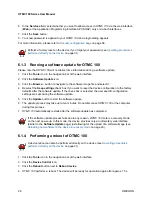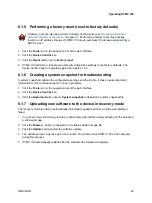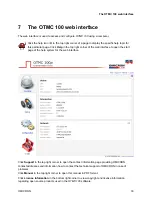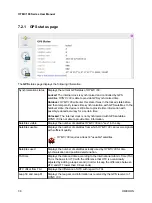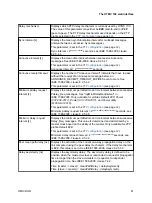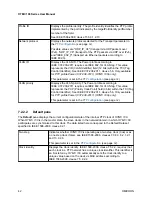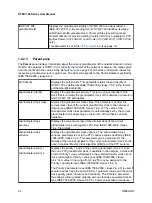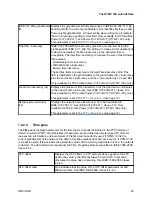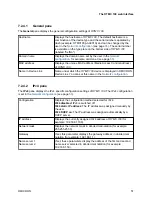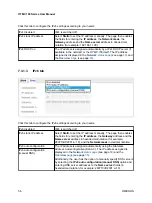
Delay mechanism
Displays which PTP delay mechanism is currently used by
OTMC 100
.
The value of this parameter may either be
E2E
(end-to-end) or
P2P
(peer-to-peer). The PTP delay mechanism used depends on the PTP
profile selected in the
Sync interval [s]
Displays the mean synchronization interval for multicast messages
(interval between successive Sync messages).
This parameter is set in the
Sync Interval = 2
Log sync interval
seconds, see IEEE 1588-2008, clause
8.2.5.4.3.
Announce interval [s]
Displays the mean time interval between successive Announce
messages. See IEEE 1588-2008, clause 8.2.5.4.1.
This parameter is set in the
Announce interval = 2
Log announce interval
seconds.
Announce receipt timeout
Displays the number of "Announce Interval" intervals that have to pass
without the receipt of an Announce message before an
ANNOUNCE_RECEIPT_TIMEOUT_EXPIRES event occurs. See
IEEE 1588-2008, clause 8.2.5.4.2.
This parameter is set in the
Minimum pdelay request
interval [s]
Displays the minimum permitted mean time interval between successive
Pdelay_Req messages. See "logMinPdelayReqInterval" in
IEEE 1588-2008.
Only available for profiles Default P2P, Power
(C37.238-2011), Power (C37.238-2017), and Power utility
(61850-9-3:2016).
This parameter is set in the
Minimum pdelay request interval = 2
Log min pdelay request interval
seconds, see
IEEE 1588-2008, clause 8.2.5.4.5.
Minimum delay request
interval [s]
Displays the minimum permitted mean time interval between successive
Delay_Req messages. This value is determined and advertised by a
master clock based on the ability of the master.
Only available for PTP
profile Default E2E.
This parameter is set in the
Minimum delay request interval = 2
Log min delay request interval
seconds, see
IEEE 1588-2008, clause 8.2.5.3.2.
Peer mean path delay [ns] Displays the estimate of the current one-way propagation delay on the
link computed using the peer delay mechanism. If the delay mechanism
is E2E, this value is zero. See IEEE 1588-2008, clause 8.2.5.3.3.
Delay asymmetry [ns]
Displays the asymmetry delay. The asymmetry delay is defined to be
positive when the master-to-slave or responder-to-requestor propagation
time is longer than the slave-to-master or requestor-to-responder
propagation time. See IEEE 1588-2008, clause 7.4.2.
Time (master -> slave) = meanPat delayAsymmetry
Time (slave -> master) = meanPathDelay - delayAsymmetry
The OTMC 100 web interface
OMICRON
41
Содержание OTMC 100
Страница 1: ...Smart Measurement Solutions OTMC 100 User Manual...
Страница 89: ...ENU 1066 05 01...


